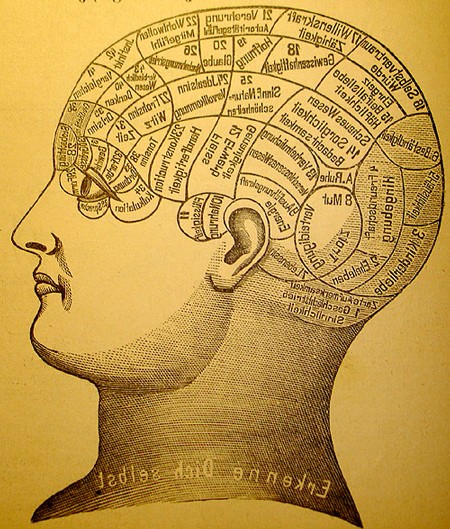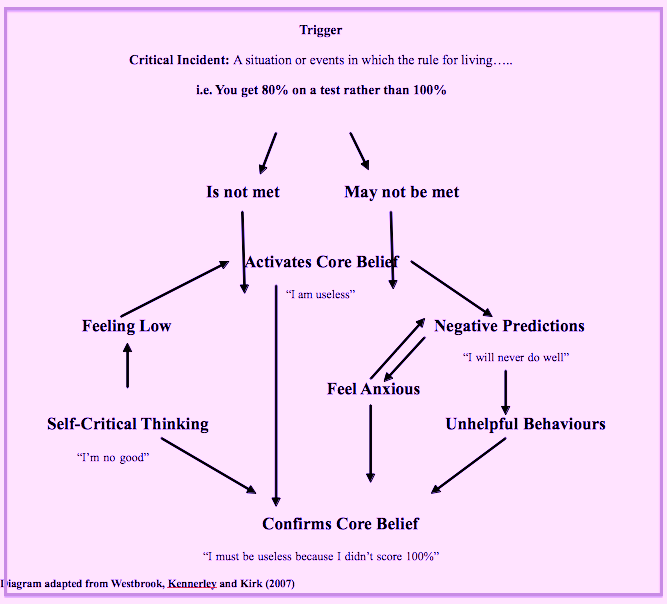CBT Formulation – Don’t Like the Idea of a Diagnosis?
 Over the last few decades a new form of counselling has challenged the way mental health is being dealt with. The ‘old’ way of dealing with the day-to-day realities of emotional health issues usually involved committing to long-term therapy sessions, talking about your childhood, and perhaps being prescribed medication. Treatment was long, could be expensive, and while often effective wasn’t always backed up with scientific evidence or proof of success.
Over the last few decades a new form of counselling has challenged the way mental health is being dealt with. The ‘old’ way of dealing with the day-to-day realities of emotional health issues usually involved committing to long-term therapy sessions, talking about your childhood, and perhaps being prescribed medication. Treatment was long, could be expensive, and while often effective wasn’t always backed up with scientific evidence or proof of success.
Then along came Cognitive Behavioural Therapy, often called CBT. This short-term and therefore often less expensive treatment prides itself on having been put through its scientific paces. Countless trials, tests and experiments highlight CBT as a useful treatment, particularly for depression and anxiety.
If you’ve ever considered trying therapy but felt turned off by years of looking at your past, and of someone giving you a ‘diagnosis’ and making you feel there is something wrong with you, then CBT might be for you. There is no diagnosis per se, but rather you work with your therapist to create a sort of ‘map’ to what you are dealing with, otherwise known as ‘CBT Formulation’.
What is CBT Formulation? And How Does it Help Me?
Formulation is a clinical term to describe a way of organising the information from a patient assessment and is an alternative to giving a ‘diagnosis’. A clinical formulation, also called a ‘case formulation’, looks at the nature and cause of your issues as a client, and then works to create a hypothesis, a starting point for further exploration. In other words, a formulation is a ‘blueprint’ for what is going on with you and how you therapist might help.
The information used to create the formulation is collected and pieced together during the first couple of sessions with your therapist or counsellor, where they gather as many details as they can about what’s going on in your life. This isn’t to say that the formulation can’t be changed or adapted later on during treatment as new information arises.
The therapist will try to cover all of the points listed below to create a formulation for you. And once it is pieced together, they share it with you. This gives you an opportunity to make sure that the therapist has all the relevant material about you and that their interpretation is the correct one.
The Key Features of a CBT Formulation
These are the things your therapist will look for when you tell them about yourself.
-
Significant Life Experiences. Childhood and adult experiences which have led to the development of ‘core beliefs’, the strong and often unconscious beliefs you have about yourself and your life that are usually behind all the choices you make.

-
Key Core Beliefs. Again, these are the big, statements you have about yourself, the world and the future. Examples would be, “I am useless” , “Nobody likes me” “ I can’t trust anyone”, ‘The world is a dangerous place”.
-
Key Dysfunctional Assumptions or ‘Rules of Living’. These are the things you see as ‘shoulds’ and ‘musts’ that help you deal with the pain of your Core Beliefs. For example, if your Core Belief is that the world is a dangerous place, you will have an assumption that “I should never trust anyone unless they prove themselves” or “I must never talk to or look at strangers in public”.
-
Triggers/Critical Incidents. Things that set your ‘problem’ off. If you suffer anxiety, it would be whatever makes you get anxious.
-
Modifiers. Things that make the problem better or worse. Looking at anxiety again, it would be what makes your anxiety worse once it’s triggered, and then what makes you start to relax again.
-
Vicious Cycles and Maintaining Factors. These are the things that keep a problem going. Perhaps constantly talking to your ex partner keeps your anxiety going and is one of your ‘maintaining factors’, with the urge to contact him when you have nothing to do on the weekend being part of your cycle.
-
Thoughts, Feelings, Bodily Sensations and Behaviour which lead to confirmation of negative self-thoughts.
A Case Study at Work- How a CBT Formulation Might Develop for a Client With Low Self-Esteem
 Above are some quick examples of how a formulation might work around anxiety. Here is a more in-depth case study of how it might work if a client has self-esteem as a ‘presenting issue’ (the main problem you feel you have that you tell your therapist about).
Above are some quick examples of how a formulation might work around anxiety. Here is a more in-depth case study of how it might work if a client has self-esteem as a ‘presenting issue’ (the main problem you feel you have that you tell your therapist about).
Significant Life Experiences (childhood and/or adult).
Significant life experiences that have led to an issue of low self-esteem may include lack of praise as a child, lack of validation, being the odd one out in the family, loss, rejection, neglect, emotional, physical or sexual abuse, and not conforming to the ‘social norm’.
Key Core Beliefs.
These will likely be mostly negative, and might be a mix of “I’m useless”, “I don’t matter”, “I’m a failure”, “People think I’m a freak”, “Nobody likes me”, “I always get hurt”, “No one cares”, and “I can’t do anything right”.
Rules for Living.
Remembering that these are ways of acting to protect yourself against the emotional pain of Core Beliefs, in the case of self-esteem issues your Rules for Living could be as follows-
Perfectionism: Creating high standards against which self-worth can be measured. i.e. “If I try extra hard then I won’t be useless”, “I do matter if I can help everyone”.
Avoiding: Escaping or avoiding situations which create a possibility of rejection. i.e. “Better not to be in a relationship than risk being hurt”, “I mustn’t let people get close”.
Seeking: Wanting any kind of attention, love, affection, or closeness at any cost. i.e. “Anything is better than nothing”, “It’s worth all the pain for the few times it’s good”.
Masks: Creating a ‘front’ that is confident, to protect the side that gets hurt. i.e. “I can’t let people see the real me”, “If they really knew me they wouldn’t like me”.
Triggers/ Critical Incidents.
Perhaps you get 80% on a test instead of 100%. This activates your core belief “I am useless”. Then you feel low and go into what’s called a ‘negative prediction’, thinking “I will never do well”. You might then put on a mask and pretend you don’t care about the test result around other students.
Modifiers.
A modifier here might be people asking you about yourself. This might always make you have less self-esteem as you assume they want to judge you. On the other side of things, perhaps being by yourself is what helps you relax.
Vicious cycles and Maintaining Factors.
Always expecting yourself to get 100% and be perfect could be one of the vicious cycles if you suffer low self-esteem. This could be maintained by always choosing situations where you are judged and compared. A person with low self-esteem might naturally choose a competitive job where they always get compared to colleagues, or date a partner who won’t commit and instead dates others, creating competition.
Thoughts, Feelings, Bodily Sensations and Behaviour .
If you suffer low self-esteem, thinking you aren’t good enough triggers feeling anxious, which might give you muscle aches or a headache, which then means you stay at home when everyone else goes out to have fun and you feel unwanted, confirming your belief that you aren’t good enough. And there’s the vicious cycle again!
But Does Formulation Really Help? Does It Really Benefit Clients?
Yes. There are many benefits to CBT formulation. Here are just a few:
-
It helps structure the choice of techniques and client ‘homework’.
-
It helps make multifaceted problems clear and concise.
-
It can help to predict possible problems and suggest ways to handle them.
-
It is created in collaboration between therapist and client so it helps with communication and trust.
-
It is flexible, in other words open to change and complete dismissal if necessary.
Conclusion
While the CBT formulation is subject to criticisms (mainly that the therapist can create a perfectly good formulation that doesn’t actually fit with the client and that the model is too simplistic), formulation has shown itself to be a powerful tool in the theory and practice of Cognitive Behavioural Therapy. It lets you as the client take an active role in organising your thoughts and acknowledging patterns between your thoughts, feelings, and behaviour.
References
Bruch, M., & Bond, F. (1998). Beyond Diagnosis: Case Formulation Approach in Cognitive Behavioural Therapy. Wiley- Blackwell.
Grant, A., Townsend, M., & Mill, J. (2008). Assessment and Case Formulation in CBT. SAGE Publications.
Tarrier, N., & Johnson, J. (2006). Case Formulation in Cognitive Behaviour Therapy: The Treatment of Challenging and Complex Cases. Routledge.
Westbrook, D., Kennerley, H., & Kirk, J. (2007). An Introduction to CBT: Skills and Applications. SAGE Publications.
Still have questions about formulation in CBT? Ask them below in the comments box. We love hearing from you!




